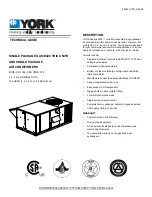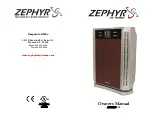
IM709
35
Fan start-up
1.
Place the unit into the "FAN ONLY" mode through the
keypad:
System summary
Control Mode
Off
Auto
Heat/Cool
Heat only
Cool only
Fan only
2.
Turn switch S7 to "ON". The supply air fan should start
and run.
3.
Observe fan rotation. If fan is rotating backward,
reverse two legs of the supply power. If fan does not
run:
a.
Check the control circuit fuse F1.
b.
Check control transformer fuse FB7.
c.
Verify that the fan overload is not tripped.
d.
Check the fan motor power fuses.
e.
Trace the circuits.
Compressor start-up
With the supply air fan operational, prepare for compressor
operation. Note: The unit is shipped with the refrigeration
service valves closed. Backseat (open) the suction, discharge
and liquid line valves and replace service caps.
Connect service gauges and crack valves off the backseat
position (one turn forward). Verify that the unit has not lost
its refrigerant charge due to shipping damage or leaks. These
should operate at least 24 hours before starting compressors.
1.
Set Cooling Control Setpoint, menu 13, to a value which
will assure a call for full cooling.
2.
Place unit into the “COOL ONLY” mode through key-
pad/display.
3.
If desired, the MicroTech internal control timers can be
reduced to 20 seconds. The amount of time it operates in
this “Fast” mode can be entered through the keypad:
Setup/Service
Timer setting
Service
Note:
"Fast" timers should only be used to verify
sequencing of compressors during start-up. The
timer must be returned to "Normal" for proper unit
operation.
Do not allow compressors to come on repeatedly in the
"Fast" timer mode as this may damage compressors and/or
will indicate "Motor Protector Failure" under compressor
alarms.
The compressors should now start. Start compressors one at
a time, beginning with compressor number 1. Facing the
unit, from left to right, compressors are numbered #1, #3, #4
and #2.
If the compressor motor hums but does not run, verify that
the unit is getting three phase power.
The compressors should run continuously. If a compressor
cycles on the low pressure switch:
a.
Verify that the circuit is not low on charge.
b.
Check for low airflow.
c.
Check for clogged filters.
d.
Check for restricted ductwork.
e.
Check for very low mixed air temperatures to the unit.
f.
Verify that all the distributor tubes, expansion valve and
liquid line components are feeding the evaporator coil.
g.
Verify that all fan section access panels are in place.
h.
Verify that the suction service valves and the liquid line
service valves are completely open.
i.
Verify that all sensor inputs are connected.
Economizer start-up
The economizer is modulated to maintain the cooling set-
point. With entering water temperature more than 3°F below
the mixed air return to the unit, place the water sensor in a
cold bath if supply water to the unit is too warm, and the unit
calling for cooling, observe that the economizer control
valve modulates open. Readjust control setting or remove
the sensor from the bath and observe that the economizer
control valve drives closed.
Hot water start-up
The hot water valve is modulated to maintain the discharge
heating setpoint. To verify the hot water valve operation,
adjust the heating setpoint through the keyboard:
Temperatures
Zone heating
OCC HTG SPT
Set the heating setpoint to a temperature greater than the
control temperature plus the dead band. Note the cooling set-
point must be higher than the heating setpoint. With the heat-
ing setpoint set properly the hot water valve should modulate
open. To close the hot water valve adjust the heating setpoint
below the control temperature minus the dead band. After
testing the hot water valve, return the heating setpoint to its
proper setting.
Expansion valve superheat adjustment
It is very important that superheat is set properly. It should
be between 10°F and 12°F under full load conditions. Lower
entering air conditions, lower airflow rates and higher con-
densing temperatures reduce the load on the expansion
valve. Under reduced load conditions, the superheat could be
as low as 6°F to 8°F. Insufficient superheat will cause liquid
floodback to the compressor and possible liquid slugging.
Excessive superheat will reduce system performance and
shorten compressor life. Verify that the sensing bulb is prop-
erly located (see Figure 26) and securely strapped to the
refrigerant line. Turn the adjusting stem clockwise to
increase superheat. Adjust the stem (maximum one turn at a
time) and observe the superheat. Allow up to 30 minutes for
the system to rebalance at the final setting.
Содержание SWT C Series
Страница 23: ...IM709 23 Typical Wiring Schematics Figure 19 Power Schematic...
Страница 24: ...24 IM709 Figure 20 Input Schematic Discharge Air Control DAC...
Страница 25: ...IM709 25 Figure 21 Input Schematic Zone or Space Comfort Control SCC...
Страница 26: ...26 IM709 Figure 22 Output Schematic Actuator Control...
Страница 27: ...IM709 27 Figure 23 Output Schematic Auxiliary Fan Start Stop Control...
Страница 28: ...28 IM709 Figure 24 Output Schematic Actuator Control...
Страница 29: ...IM709 29 Figure 25 Output Schematic Compressor Control 4 Compressors 4 5 or 6 Stage...
Страница 44: ...13600 Industrial Park Boulevard Minneapolis MN 55441 USA 763 553 5330...










































